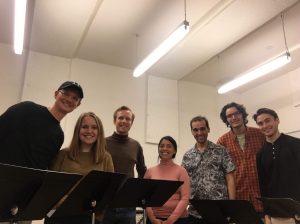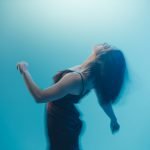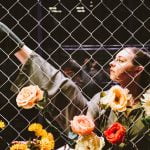Inside the Creation with Composer Andrew Maxfield
- What made you want to become a composer?
I’ve been “composing” since I was a little kid—I would lie on the carpet by my parents’ piano, scribbling on my mom’s music staff paper, and then ask her to play what I wrote. Somewhere along the line, like 30 years later, I finally accepted the diagnosis of being a “Composer.” Writing music is like playing three-dimensional Sudoku, and it’s my kind of fun, I guess.
- What was the process like for creating the music and sound for When I am Lost, We Speak in Flowers?
The process was rushed and exciting. Michelle Nielsen pitched the idea around six weeks before the show was supposed to open. Normally, I’m booked about 12 months out, but I wanted to do it because I loved SALT. I knew the turnaround was quick, so I conceived of this weird idea of recording short musical vignettes with a vocal ensemble here in Boston and then manipulating (looping, editing, etc.) the clips after the fact to create the whole “soundtrack.” I believe in finding creativity through constraints, and these time and design constraints created a very exciting creative process.
- Where did you draw inspiration from for this piece?
First, SALT requested a vocal score. So I naturally turned to vocal music—some newfangled stuff with chattering and talking woven into the music, some very old stuff, which is where music comes from anyway. Second, I looked at the videos of the choreography and contemplated the gestures I was seeing—not just the steps and moves, but the human gestures and stories, the big story arc. I tried to mirror in the human voices the energy, whimsy, joy, surprise, sadness, frustration, disappointment, and so forth that I felt as I watched the dance.
- Can you give us some insight into how you compose? What methods do you use?
I start by trying to find a spark—some kind of little concept that I can spin into larger bits and then use as a sort of basic building block for whatever piece I’m writing. For this piece, I watched the video of early versions of the choreography, and started to see the four major stories as four contrasting musical areas. In particular, I saw Myles do this incredible solo routine where his moves were shadow-repeated by Logan in the background. I thought: “ah, I want a primary melody that can repeat on top of itself as a canon.” From there, I sit at my piano and write with a pencil and paper until all of the major ideas are totally clear to me. The vocal ensemble recorded from my pencil manuscripts. Then, in this case, a second round of “composing” began when I imported the vocal audio files into my software and began creating the larger forms—and this was an intuitive process, like painting.
- What made you go with music and sound versus a more traditional composition?
I wanted to locate the four main stories spatially, to help the viewer follow the transitions as we pivot from one to another. Given that these different stories were taking place in different locations (at least that’s how I read it), I attached each to different location-specific, ambient sounds. Those sounds are as interesting to me as any of the “musical” sounds I was writing, and so I viewed the combination as the “composition.”
- How did you choose the vocal performers for this work?
Nightingale is a cool experimental vocal ensemble in Boston. I know some of the members well, and they came to mind when I heard about this project.
- Is your process for creating dance compositions different from creating other compositions?
In this case, yes, because I could watch early versions of the choreography as I composed. It was a little more like writing a film score.
- When you’re not composing, what do you enjoy doing?
I’m a dad to two high-octane boys, which means I’m chasing them in every minute I’m not doing something else. I don’t remember the last time I had discretionary time. Pre-kids, I liked to read … I think. I can’t remember anymore. I need a nap!
- When interviewing the dancers, they discussed how different it was for them to have the movements before the music. Did this impact the choices and intentions behind the music and sound you created?
Yes, I thought this was a wonderful creative opportunity. If they had said “here, write 7 minutes of music for this pas de deux,” I would have written something totally different. Probably something too busy, musically. Seeing the dance was amazing. I would actually watch in on repeat in fast motion so that I could see the basic contours of the motion—the lifting, the sudden changes, the group and individual dynamics, etc. Then I would think about how to support what I was seeing with music and sound. It was so fascinating and fun.
- Which composers or musicians inspire you? or inspired this work?
Sheesh. Inspiration is everywhere. For this piece, I found inspiration in some geeky keyboard harmony exercises, the Golden Gate Quartet, some Eastern European folk music I heard at a Christmas party last year, music by Steve Reich, Bela Bartok, and my brother Stu. And the sound of photocopiers.

(Andrew with Nightingale)




